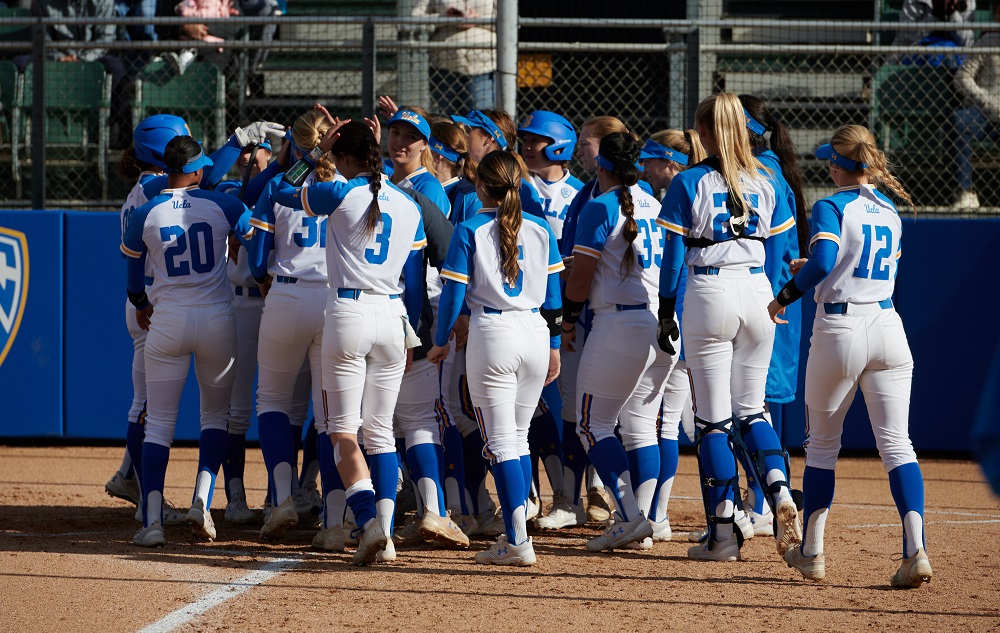The 2020 season was shaping up to be one of the best in recent memory. When the NCAA’s initial RPI was released – weeks earlier than in the past – teams like UCF, Duke, and Fresno State were ranked in the top 12 nationally. Upsets were no longer a rarity, and good teams had already begun to prove themselves as truly great teams.
Unfortunately, thanks to the COVID-19 pandemic, we’ll never know for-sure how the full season would have played out or what the postseason would have looked like. However, using mathematical calculations, we have an opportunity to see what could have been; In the Circle podcast host and longtime softball bracketologist Eric Lopez put on his Selection Committee hat and projected the field of 64.
Let’s take a look at what the 2020 NCAA Tournament could have looked like:
Los Angeles Regional:
(1) UCLA
San Diego State
Cal State Fullerton
Sacramento State
Just a year removed from their 2019 National Championship, the Bruins entered the 2020 season with a lot of questions, but quickly put any doubts to rest with stellar play during the early portion of the year. Megan Faraimo did a more-than-capable job of helming the team’s pitching staff, while transfers Jenavee Peres and Delanie Wisz fit right into the team’s offense… San Diego State would have been an at-large selection out of the Mountain West, while Cal State Fullerton and Sacramento State were automatically in the field as their respective conference champions.
Durham Regional:
(16) Duke
Georgia
Eastern Kentucky
Gardner-Webb
The Blue Devils got off to a red-hot start to the 2020 campaign in just the program’s third year of on-field existence. Marissa Young’s squad was 23-4 when the season ended, including victories over Texas, UCF, and North Carolina State. Georgia was #33 in the initial RPI release, but reached #21 in the mathematical simulation for the full season. Eastern Kentucky and Gardner-Webb would each have joined the field as automatic qualifiers from their respective conferences.
Blacksburg Regional
(9) Virginia Tech
Michigan
Tennessee
Norfolk State
Hosting one of a handful of stacked regionals in the projections, Virginia Tech would have earned their second-consecutive ACC regular-season title, according to the simulation. Michigan likely would have been a team in consideration to host a regional, but instead earned a #2 seed and would have faced off against a Lady Vols program that struggled mightily in the early portion of the year.
Tuscaloosa Regional
(8) Alabama
James Madison
Clemson
UNC-Greensboro
A familiar spot for the Crimson Tide, the simulation placed the program as the 8th-overall seed in the field. Traveling to Tuscaloosa would’ve been the James Madison Dukes, a team that hosted their own regional not that long ago. One of the projected tournament’s best storylines would have been a familiar opponent in Tide town, the Clemson Tigers, who have become one of the Tide’s greatest foes on the gridiron. A multi-dimensional rivalry between the two programs could have been tremendous.
Gainesville Regional
(5) Florida
Florida Gulf Coast
South Florida
Long Island
The SEC regular-season and conference champions, the Gators were also seeded in a familiar place at the #5 overall seed, but with far less opposition than a year ago. The Gators were another team that entered 2020 with significant questions, but their pitching staff shored up through the course of the year and put the Gators in position to run the gamut in a difficult SEC. Florida Gulf Coast earned the ASun’s automatic bid in the simulation, while in-state opponent South Florida was one of the last four teams in the field.
Orlando Regional
(12) UCF
Florida State
Iowa
Boston
One of the non-conference season’s biggest stories, UCF would assuredly have been in the hosting conversation after a solid showing in the early portion of the year and running the gamut in American Conference play. Ranked 10th in the full-season RPI simulation, the Knights would have played host to a Florida State team that perennially contends deep into the postseason, including the 2018 National Championship. Iowa was one of the last four teams in the tournament in the projection, and their placement in the Orlando regional would put head coach Renee Luers-Gillispie back in a place where she spent nearly two decades.
Lexington Regional
(13) Kentucky
Liberty
Louisville
Illinois-Chicago
Two of the nation’s best offensive players, Alex Martens and Bailey Vick, resided in Lexington this season, providing a dynamic duo that fit two completely different skill sets, with Vick as the table-setter and Martens an RBI machine. The Liberty Flames reached the tournament as an at-large selection out of the ASun, according to the simulation, while UK’s archrival Louisville’s inclusion as one of the last four teams in the tournament would have given this regional a built-in storyline that should have brought in every softball fan in the Bluegrass state.
Tucson Regional
(4) Arizona
South Carolina
Texas Tech
New Mexico State
Mike Candrea’s team is one of the most legendary in the game’s history, and the program ended a years-long WCWS drought by reaching the tournament’s final round in 2019. The Wildcats finished third in the stacked PAC-12 in the simulated season, and would have hosted the SEC’s South Carolina and Big 12 foe Texas Tech, as well as New Mexico State via automatic bid as the WAC champions.
Seattle Regional
(3) Washington
Notre Dame
Ball State
George Washington
Washington-George Washington could be something of a nightmare for a play-by-play broadcaster, though the Huskies rated a manageable regional field that also includes ACC at-large selection Notre Dame and MAC champion Ball State, a first-round matchup that would pit the Fighting Irish against one of their all-time program greats in Ball State head coach Megan Bartlett.
Starkville Regional
(14) Mississippi State
Minnesota
Stanford
Villanova
A top-16 seed assuredly could have been in the cards if the Bulldogs had continued their hot start to the season, but their regional would have been a tough one with the Big Ten’s Minnesota as the #2 seed, along with Jessica Allister and Stanford and Big East-champion Villanova, who had already beaten a pair of top-dollar teams in Florida State and Baylor before the season was cancelled. Mississippi State finished 13th in the simulated RPI, third in the SEC standings.
Eugene Regional
(11) Oregon
Fresno State
BYU
Monmouth
After a tumultuous 2019, the Ducks were well on their way to returning to national relevance this season. A 4th-place finish in the simulated PAC-12 conference season earned the Ducks the 11th-overall seed in the tournament, with Mountain West champion Fresno State – ranked 15th in the simulated final RPI – as the #2 seed in the regional. West Coast Conference champions BYU and MAAC champs Monmouth rounded out the field at Jane Sanders Stadium.
Austin Regional
(6) Texas
McNeese State
Houston
Columbia
It was just a year ago that the Longhorns the opening game of their regional, a first for Mike White in his head coaching career. The Horns were the only team to beat both UCLA and Washington during the portion of season that was actually played, though the season simulation had the program tied with Oklahoma State for the Big 12 regular-season title and losing to the Cowgirls in the tournament championship. The 2020 set of teams in Austin also promised to be a competitive group, with Southland champs McNeese State earning the #2 seed in the regional after finishing 24th in the simulated final RPI. Houston earned an at-large from the American Conference, while Columbia continued their recent dominance of the Ivy League and would be the automatic qualifier from that conference.
Stillwater Regional
(7) Oklahoma State
Utah
North Texas
South Dakota State
While the simulations showed the Cowgirls tied for the regular-season Big 12 title and winning the conference tournament, the team was the second-ranked team from the conference in the field of 64. The Cowgirls 19-5 at the season’s abrupt end, with losses only to three SEC teams and Louisiana-Lafayette. Carrie Eberle and Logan Simunek had established quite a rapport as a 1-2 punch for the Cowgirls in the circle. On the road in Stillwater via the bracket selection were the PAC-12’s Utah, earning the #2 seed after a resurgent year. Conference USA champion North Texas, one of the nation’s top success stories over the past two years, and Summit League simulated champion South Dakota State rounded out the regional field.
Fayetteville Regional
(10) Arkansas
Oklahoma
Oregon State
Southern Illinois
Quite possibly the bracket’s biggest controversy was the Fayetteville regional, with perennial WCWS-contender Oklahoma traveling to be the #2 seed in the Razorbacks’-hosted field. The Sooners finished tied for fourth in the simulated Big 12 standings, a sharp turn from their usual league dominance. Arkansas finished the shortened season 19-6, projected to finish, tied for 8th in the SEC standings. The Hogs hosted a regional in 2018, but have fallen short of that level since. An interesting regional all-around by the simulated committee, including an at-large selection for the PAC-12’s Oregon State.
Baton Rouge Regional
(15) LSU
Arizona State
Northwestern
Texas Southern
LSU’s pitching staff was undoubtedly the nation’s deepest and best in the early portion of the season, though the simulator only had them finishing 19th in the final RPI and tied for fifth in the SEC standings. The field of 64 matched the Bayou Bengals up with the big bats of #2-seed Arizona State and 2019 regional host Northwestern, a talent-stacked grouping of teams.
Lafayette Regional
(2) Louisiana-Lafayette
Texas A&M
Baylor
Stony Brook
The Ragin’ Cajuns were ranked #1 in the initial RPI, and finished #2 in the simulated final RPI rankings. A lack of scheduling – the issue that plagued the Cajuns a year ago – was a non-factor in 2020. The Cajuns played a tough schedule in the non-conference portion of their season, and would have another tough go in the regional. Texas A&M and Baylor were two teams in a resurgent year after respectively bad 2019s, and either or both could have given the Cajuns a run for their money.


